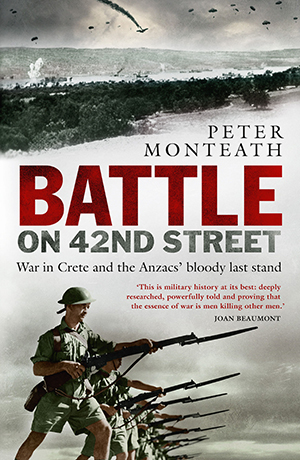In 1940 the 42nd Field Company (British Engineers) set up a bivouac straddling a dusty road running North-South near Suda Bay on Crete.

Paperback 272pp RRP $34.99
They named the road ‘42nd Street’ before moving on, but the name was to remain. Monteath has chronicled the events leading to May 1941 when war came to Crete: the strategic significance of the island and its airfields, the troops involved and their leaders, as well as comprehensive descriptions of the individual battles as the Germans pushed eastwards to eventually capture Crete.
The reader is iinitially confronted by The bayonet: A short, sharp history! A concise coverage of Western Desert and Greece exploits prior to evacuation follows. Major General Bernard Freyberg VC, Commander 2nd New Zealand Expedtionary Force arrived on Crete after evacuation from Greece and was appointed Commander British and Commonwealth Forces, Crete (Creforce) on 1 May 1941. Accompanying his NZ division were the Australian 6th Division soldiers of 2/7th Bn AIF and 2/8th Bn AIF. With virtually no heavy weapons available and only local telephones for internal communication, the Anzacs prepared for the inevitable German airborne assault (Ultra had decryptrd the German codes at this time) – with major attention to concealment to deny the enemy of their numbers and dispositions.
Meanwhile the Luftwaffe had assembled a virtual armada of aircraft and gliders to invade Crete from the air, then seize airfields and, after securing the Suva Bay naval facilities, using seaborne men and equipment to hold the island (almost 23000 men in total). Invading on the 20th May, the German timetable was considerably slowed by the unexpected opposition met and large number of casualties suffered, but with relentless bombing and strafing, had by 26th May driven the defenders to Canea (adjacent to Suva Bay).
Determined not to let the naval facilities fall, the two Australian and five NZ battalions lined the eastern side of 42nd Street and awaited the Germans on 27th May. Triggered by a 2/7 Bn ambush followed by a 28th Bn New Zealand Haka, five battalions leapt from their hastily prepared positions, attacking the Germans and pursuing them with fixed bayonets. 21st Bn, the NZ reserve battalion, was not going to be deprived of the action and joined the deadly fracas. A considerable number of first-hand accounts from all involved elaborate on the battle.
Sheer German combat power was to prevail by 1st June, but not before over 12000 were evacuated to Egypt from the beach at Sfakiia (SE Crete) between 28 May and 1 June. Those for whom no evacuation was possible, took their chances in evading the Germans and being rescued by clandestine Britsh vessels, or remained prisoners of war in Germany. Considerable German retribution was carried out on the Cretans during the German occupation of Crete.
Monteath’s work should be a ‘must’ in every Australian and New Zealand collection of World War II history. This volume is very readable, well-referenced and with very clear battle maps and an excellent collection of photographs.
[The 2/7th Bn and 2/8th Bn who fought at 42nd Street remain on the Australian Order of Battle today as the 8/7th Battalion, Royal Victoria Regiment which retains both the 2/8th Bn colour patch and ‘Crete’ as one of the Battle Honours on its Regimental Colours.
Reviewed for RUSIV by Neville Taylor, October 2019
Contact Royal United Services Institute about this article.






